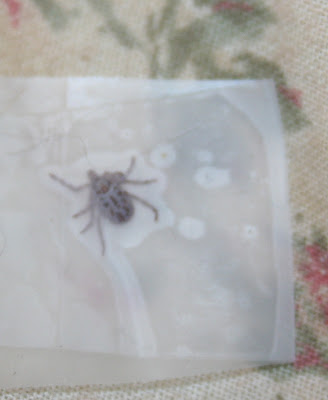By Linda Cole
Garden plants are a safe and natural way to control fleas and mosquitoes, but they can also be used to help repel ticks and keep tick carrying animals, like deer, out of your yard. I’d like to thank Frankie Furter, a very handsome black and tan dog, for inspiring this post. When I wrote my article on Garden Plants that Repel Fleas, Frankie asked if there were any plants that could help repel ticks. This article is especially for you, Frankie! I hope it gives you some ideas to help keep those nasty ticks out of your yard and your fur.
There hasn’t been a lot of research done on ticks and garden plants, which is odd considering how much harm ticks can cause not only pets, but people too. Wild animals, especially deer, can carry ticks into your yard when they visit a garden for plants they are attracted to. Ticks can also be carried in the wind from a nearby grassy or wooded area, and they love moist and humid places. Finding just one tick, even on your pet, can give you that creepy feeling that something is crawling up your leg, into your hair.
Lavender
There are many varieties of lavender. It’s a perennial with a very nice smell that most people are familiar with. But as beautiful as this flower is, ticks, moths, mice, the pesky black fly, mosquitoes and fleas can all do without it.
Lemongrass
Lemongrass is believed to be a plant that repels ticks. It’s a good companion plant with lavender. You can eat lemongrass, and it’s a popular ingredient in Vietnamese and Thai dishes. It does have a lemon smell, but depending on who you ask, the taste is a light hint of ginger for some or a mild lemon taste for others. It grows best in the southern U.S.; it can be grown up north, but will need to be taken inside during the winter.
Geranium
Caution: All parts of this plant are toxic to dogs and cats. So if you have outside cats or have other cats that wander in your yard, it’s best to not plant geraniums. Most dogs and cats will instinctively avoid plants that are toxic to them, but not all of them do. If you have a safe spot in your garden for geraniums, they are said to repel ticks. To help keep cats out of your garden, especially if you have plants that are toxic to them, you can plant rue. It’s also a garden plant that repels fleas.
Members of the mint family
Catnip, sage and mints are all thought to help repel ticks from yards. The nice thing about catnip and all mints, like peppermint, chocolate mint or apple mint, is that they are perfectly safe to use around pets. They can be dried and spread in your pets’ bedding and around the house to help drive ticks and fleas out. If your pet eats part of the plant, it won’t hurt them. Just remember, mints are invasive and will wander all over the yard if they aren’t planted in pots, and you need to keep different varieties away from each other to keep them from cross pollinating.
Tips to help keep ticks out of your yard
Ticks like to hide in tall grass, so keeping your lawn mowed and tall grasses cut down around the areas where you and your pet like to hang out will help take away a tick’s hiding spot. Creating a path of cedar chips around areas where your pet spends most of their time will stop ticks from getting in that area. Cedar chips are also good for repelling fleas, but they are toxic to pets, so if you use them, monitor your pet to make sure they aren’t eating any chips. Planting catnip along the border of a cedar chip path is a perfect place for this plant, because it keeps it away from other garden plants that could be damaged if a cat decides to roll in the catnip. Lemongrass or any other of the above plants are also good border plants.
How to keep deer out of your yard
Not everyone wants a 10 foot fence around their yard just to keep deer out. However, planting the right plants in the right places can help keep deer at bay. They find their favorite food by smell, but you can place garden plants around the perimeter of your yard to help keep deer out. Good plants to use that repel deer include different varieties of sage, yarrow, oregano, lemon balm and black-eyed Susan. These plants have a strong odor that deer don’t like, and they cover up the smell of garden plants deer like to eat. If they can’t smell what they’re looking for, deer will most likely avoid your yard. Keeping them out of your yard can help keep ticks out as well.
Photo: Audrey in the Garden, by Tapir Girl
Read more articles by Linda Cole






